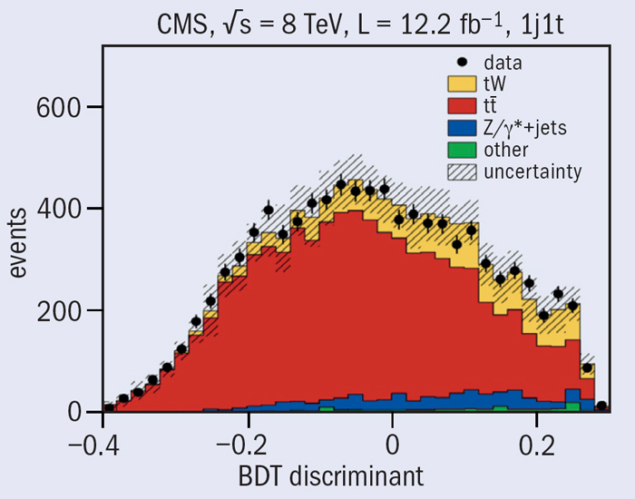The top quark remains, nearly 20 years after its discovery by the experiments at Fermilab’s Tevatron, the heaviest particle known. Its production and decays continue to be the subjects of extensive studies, both at the Tevatron and at the LHC. While top quarks are predominantly produced in pairs through the strong interaction, the production of single top quarks is also possible by virtue of the electroweak interaction, albeit with a much smaller production cross-section. This latter production mechanism provides a unique window into the dynamics of the top quark.
Three different production channels for single top quarks can be distinguished: the t-channel, the s-channel and the W-associated channel (figure 1). After many years of intensive searches, the Tevatron experiment collaborations first reported the observation of singly produced top quarks in 2009. These initial searches were optimized for the t- and s-channel production modes combined. Later, the t-channel mode was individually established by experiments at the Tevatron and the LHC, while evidence for s-channel production was reported only recently by the D0 collaboration at the Tevatron, in July 2013.

Meanwhile, the third production mechanism, W-associated production, remained out of the Tevatron’s reach because of its small cross-section and the lack of a sufficiently distinctive signature. At the LHC, however, the production rate for top quarks is much higher. This allowed ATLAS and CMS to report evidence of W-associated production already with the data collected at a centre-of-mass energy of 7 TeV in 2011, although these measurements did not reach the 5σ gold standard for the solid observation of a new signal. Now, thanks to the data collected in 2012 with the LHC operating at a centre-of-mass energy of 8 TeV, the CMS collaboration has been able to complete the experimental picture of the family of single top-quark production mechanisms.
The main background to W-associated production comes from pair-produced top quarks, where the decay of one of the top quarks appears W-like, because the b quark into which it decays fails the b-tagging requirements. No single defining feature separates the two processes sharply, so several kinematic properties have been combined into a single multivariate discriminant by a boosted decision tree – a machine-learning technique that is particularly suited to separating tiny signals from overwhelming backgrounds. Figure 2 shows the discriminant from the boosted decision tree.

The amount of signal in the selected sample is inferred by a fit to the discriminant distribution. To constrain tightly the amount of top-quark pair background with the data, two complementary samples with one additional jet, separated into cases with one or both jets b-tagged, are also included in the fit. The relative population of the samples with one or two b-tagged jets – both of which are almost pure in top-quark pair events – proves to be a powerful handle to reduce the uncertainty on the b-tagging efficiency, and therefore improve the precision of the analysis.
The excess of events with respect to the background-only hypothesis is quantified at a significance of 6.1σ (with 5.4±1.4σ expected from simulation), and the cross-section is found to be 23.4±5.4 pb, in agreement with the Standard Model prediction. Two cross-check analyses, less sensitive but relying on fewer modelling assumptions, confirm the result, therefore further supporting the first-time observation of this new single-top production mode.
This result opens the door to future searches for anomalous interactions of the top quark with the W boson, in a production mode that brings complementary information to studies that have so far been performed only with selections optimized for the more abundant top-pair and single top-quark t-channel events.
Further reading
CMS collaboration 2014 arXiv:1401.2942 [hep-ex], submitted to Phys. Rev. Lett.





